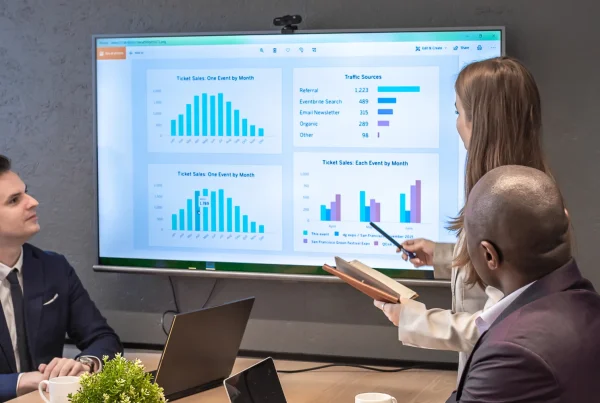#4 in Our SaaS Merchandising Blog Series
Software as a Service (SaaS) has transformed how organizations use software—and thus transformed the very nature of business. Several technology and market trends are reshaping both SaaS vendors and the organizations they serve. These trends include:
- Widespread Artificial Intelligence
- Prevalence of Centralized Analytics
- Proliferation of Vertical SaaS
- Built-in Application Programming Interfaces
- More-Democratic Pricing
SaaS Trend: Widespread Artificial Intelligence
It’s time for a SaaS retail revolution! The retail industry, like all business, is awash in unprecedented amounts of rich, real-time customer data. But that says nothing about whether individual retailers access that information, or use it efficiently, or share it widely, or gain competitive insights from it, or put those insights into profitable action.
This one is particularly frustrating—and eminently solvable.
Retailer Challenge: Inefficient Processes for Planning, Analytics, and More
As SaaS continues growing its software market share, and more organizations take deeper advantage of AI’s benefits—speeding and simplifying complex tasks, identifying growth opportunities, predicting customer wants and creating personalized solutions—SaaS is increasingly the engine driving AI’s dominance.
Look at it this way: SaaS provides AI and machine learning (ML) systems with a huge and growing dataset to analyze and learn from—the perfectly rich and diverse playground that AI needs to continually improve. AI’s surging penetration is no truer for SaaS than it is for all software. But SaaS reaches a far wider business customer base.
Basically, AI and ML ensure organizations gain increasingly more return on diminishing resources. AI and ML enable SaaS users to optimize their operations and improve the customer experience by, say, automating AI-powered chatbots. SaaS vendors use them to automate the SaaS onboarding process. AI-based predictive analytics accurately forecast future outcomes. And so on.
Alphabet CEO Sundar Pichai said artificial intelligence will have a more profound impact on humanity than fire or electricity—and that was way back in 2018.
SaaS Trend: Prevalence of Centralized Analytics
Investment in, and the value of, analytics-centric SaaS models is rising rapidly. It seems certain that centralized analytics is destined to take its place at the core of almost every service-based software platform in the years ahead.
Centralized analytics enable companies to analyze data from multiple sources, providing a comprehensive view of their operations from a “single point of truth.” It reveals vital, hidden insights and makes them available to the team members who need it most, and makes business intelligence and data-driven decisions more powerful. All told, centralized analytics strongly promotes business success and provides a competitive edge.
For better or worse, organizations are collecting more data than ever. Collection is the easy part; the greater challenge is sifting through that data for actionable insights. That’s precisely what centralized analytics solves.
SaaS Trend: Proliferation of Vertical SaaS
The COVID pandemic created the conditions for supercharged growth in the overall SaaS market, but it lent an especially welcoming hand to companies offering SaaS applications intended for niche verticals.
Vertical SaaS solves pain points in specific industries—healthcare, automotive, publishing—instead of adding value to the horizontal business functions found in virtually every sector and industry, such as sales and marketing. Companies looking to benefit from such specialization find vertical SaaS a cost-effective option for customizing key features.
The influence of vertical SaaS companies is likely to grow as they saturate the less-than-mature markets in which they typically play. Fewer competitors, and their special expertise, enables these SaaS vendors to develop strong customer relationships, setting the stage for ongoing growth.
Investors and venture capitalists have noticed, enabling public vertical SaaS companies to continually raise money since 2020.
SaaS Trend: Built-in Application Programming Interfaces
Many, perhaps most, organizations want to integrate their SaaS applications with existing business systems for the synergies they’ll produce. (Some companies wish to migrate all their data to a cloud platform, which takes the integration issue out of their hands.) In response, an increasing percentage of SaaS vendors are providing integration capabilities through open APIs rather than relying on third-party integration vendors.
The move to API-led SaaS has produced at least one dramatic benefit: Much faster deployment. According to industry estimates, implementation operations that a decade ago took 54 hours to complete, on average, are today down to 7 hours—driven primarily by API integrations. That’s quite a boost.
Simple API calls not only make it easy to integrate new SaaS applications with an existing technology stack—they also enable organizations to keep their product roadmaps fluid and future SaaS buying decisions flexible.
The API market continues to grow and influence SaaS buying decisions.
SaaS Trend: More-Democratic Pricing
To draw in more customers, and increase the odds customers feel they’re getting good value—and thus the odds they’ll opt in to, and then continue using, the service—SaaS vendors are migrating from tiered-subscription pricing to a more customized usage-based pricing model.
There’s no doubt that pricing models are hugely influential in SaaS buying decisions. The market grew when SaaS vendors moved from per-seat pricing to tiers, which better enabled customers to choose packages according to their needs.
Now “pay as you go” consumption pricing enables users to pay only for what they use. Because it lowers or even eliminates a customer’s cost when their usage is low or drops significantly (perhaps to zero), such pricing encourages customers to stay in the relationship. And we all know the cost of acquiring new customers far exceeds the cost of holding onto the ones you have.
You might consider this emphasis on keeping their customers, rather than sourcing new ones, another SaaS industry trend. As noted above, the COVID pandemic created fantastic growth in the SaaS market. For some companies, that growth is proving unsustainable, so they’ve turned a bit inward. But learning to take better care of your customer base is not necessarily a bad thing.
Take the Next Step
Want to turn your data into actionable insights that drive bottom-line growth across your entire value chain?
This is the fourth in a series exploring the power of SaaS platforms to transform retail merchandising.
Go on to the next (and final) blog in the series …
Start at the beginning with …
Jump around as you please …





